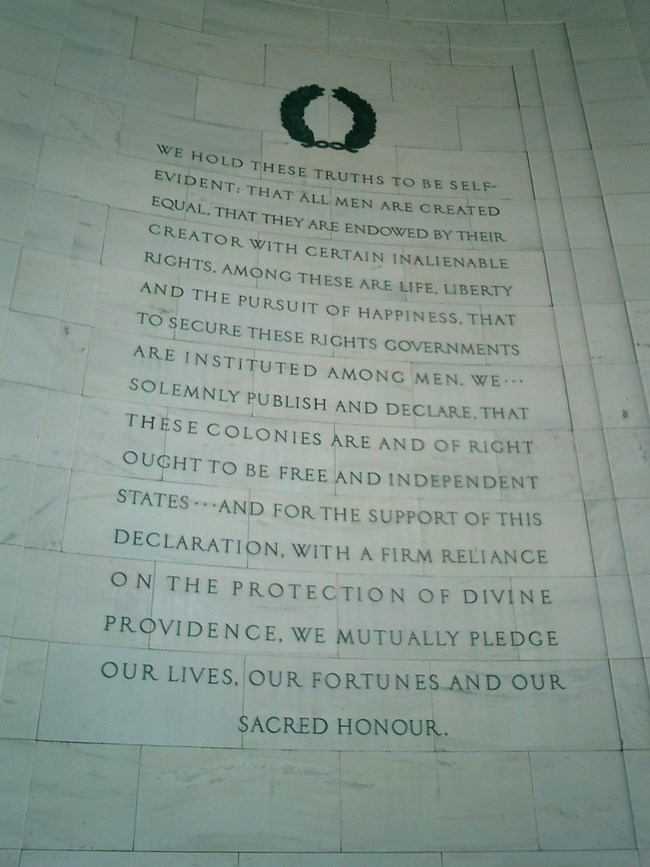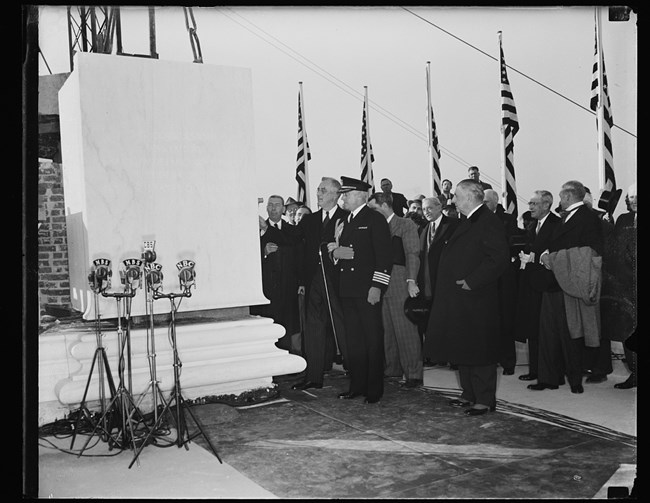Part of a series of articles titled Jefferson Memorial Education Series: Quoting Out of Context?.
Article
Jefferson Memorial Education Series: “I Like the Way You Have Worked Out the Inscription”

NPS
Grade Level
Eighth Grade; Ninth through Twelfth Grades
Objective
Compare an inscription in the Jefferson Memorial to the full text of the Declaration of Independence. Analyze whether the differences between the passage in the memorial and the primary source alter or affect the meaning.
Vocabulary
derive: obtain something fromendow: to give or furnish
inalienable: unable to be taken away
inscription: words that are written or engraved on a surface
quotation: a group of words taken from a text or speech and repeated by someone other than the original author or speaker
quoting out of context: the practice of misquoting someone by shortening what they said or by leaving out surrounding words or sentences
reliance: dependence or trust in something

Library of Congress
Essential Questions
Does the inscription in the Jefferson Memorial of the Declaration of Independence fairly represent Thomas Jefferson's beliefs and philosophies? How can quoting out of context affect the meaning of a text?
Quoting the Declaration of Independence
On May 13, 1941, members of the Thomas Jefferson Memorial Commission sent President Franklin Delano Roosevelt their recommendations for the inscription of the Declaration of Independence.
Original recommendation sent to Roosevelt in May 1941
WE HOLD THESE TRUTHS TO BE SELF-EVIDENT: THAT ALL MEN ARE CREATD EQUAL: THAT THEY ARE ENDOWED BY THEIR CREATOR WITH CERTAIN INALIENABLE RIGHTS: AMONG THESE ARE LIFE, LIBERTY AND THE PURSUIT OF HAPPINESS: THAT TO SECURE THESE RIGHTS GOVERNMENTS ARE INSTITUTED AMONG MEN, DERIVING THEIR JUST POWERS FROM THE CONSENT OF THE GOVERNED. WHENEVER ANY FORM OF GOVERNMENT BECOMES DESRUCTIVE OF THESE ENDS IT IS THE RIGHT OF THE PEOPLE TO ALTER OR ABOLISH IT.
Roosevelt replied, “I think these inscriptions are excellent. However, I do miss the last paragraph of the Declaration of Independence. It seems to me that that is so familiar and so important that it should appear somewhere.”[1] The commission wanted to accommodate the president's wishes. But if they simply added the last paragraph, the inscription wouldn't fit on the wall of the memorial. The quote would have to be shortened. The commission decided to remove this section:
“That to secure these rights, Governments are instituted among Men, deriving their just powers from the consent of the governed, --That whenever any Form of Government becomes destructive of these ends, it is the Right of the People to alter or to abolish it…”
They removed several other words and even entire sentences to shorten the inscription and maintain visual balance, so that the quotations on each of the four panels of the memorial looked similar.
The revised inscription reads:
WE HOLD THESE TRUTHS TO BE SELF-EVIDENT, THAT ALL MEN ARE CREATED EQUAL, THAT THEY ARE ENDOWED BY THEIR CREATOR WITH CERTAIN INALIENABLE RIGHTS, AMONG THESE ARE LIFE, LIBERTY, AND THE PURSUIT OF HAPPINESS, THAT TO SECURE THESE RIGHTS GOVERNMENTS ARE INSTITUTED AMONG MEN. WE…SOLEMNLY PUBLISH AND DELCARE, THAT THESE COLONIES ARE AND OF RIGHT OUGHT TO BE FREE AND INDEPENDENT STATES…AND FOR THE SUPPORT OF THIS DECLARATION, WITH A FIRM RELIANCE ON THE PROTECTION OF DIVINE PROVIDENCE, WE MUTUALLY PLEDGE OUR LIVES, OUR FORTUNES, AND OUR SACRED HONOUR.”
President Roosevelt approved of these changes, stating, “I like the way you have worked out the inscription.”[2]
Guiding Questions
- Why do you think the commission chose the Declaration of Independence to be one of the four inscriptions?
- Read the original inscription proposed by the memorial commission. What is the central idea of this quotation?
- Now read the inscription as it appears in the memorial. What has been added? What has been removed? Has the meaning or emphasis changed?
- Which of the two do you think better represents the Declaration of Independence?
- Do you agree with Roosevelt that the preamble and conclusion are the most recognized sections?
- Do you think the commission should have included the missing text?
- Is this an example of quoting out of context?
Your turn
Imagine that you are a member of the Thomas Jefferson Memorial Commission. Review the original text of the Declaration of Independence from the National Archives. Compose your own inscription for the Jefferson Memorial from the document. There is a 100-word limit in order to fit the text on the memorial wall. Which section(s) of the Declaration of Independence would you have recommended?
For Teachers
On June 26, 1934, Congress passed a Joint Resolution establishing the Thomas Jefferson Memorial Commission which included a Sub-Committee on Inscriptions. The committee included Stuart Gibboney, president of the Thomas Jefferson Foundation which owns and operates Monticello, Utah Senator Elbert Thomas and Brigadier General Jefferson Randolph Kean, a descendant of Thomas Jefferson. Their task was to select five quotations that would be as equally impressive as the Lincoln Memorial’s Gettysburg Address and Second Inaugural Address. After extensive research, they concluded that there were an overwhelming number of documents and letters that showed Jefferson’s support for “principles that became part of our American tradition.” Each one equally as important and equally deserving of a place within the memorial. They were however, limited to a certain number of words per panel. Therefore, to fit in as many principles as possible they decided to “remove them (words) from their time and original text” and combine them. By doing so the committee hoped to show Jefferson’s role in shaping “American principle and freedoms.” [3]
[1] Franklin Delano Roosevelt, letter to Stuart Gibboney May 15, 1941 FDR library.
[2] Roosevelt letter to Gibboney
[3] Elbert Thomas, Congressional Record Proceeding And Debates of the 80th Congress, second session, Volume 94-Part 10, March 8, 1948 - May 10, 1948, Page A2487
Tags
- national mall and memorial parks
- thomas jefferson memorial
- jefferson memorial
- national mall and memorial parks
- inscriptions
- memorials
- education program
- lesson plan
- declaration of independence
- thomas jefferson
- thomas jefferson memorial
- franklin d. roosevelt
- inscription
- lesson plans
- america 250 nps
- america 250
Last updated: January 28, 2025
